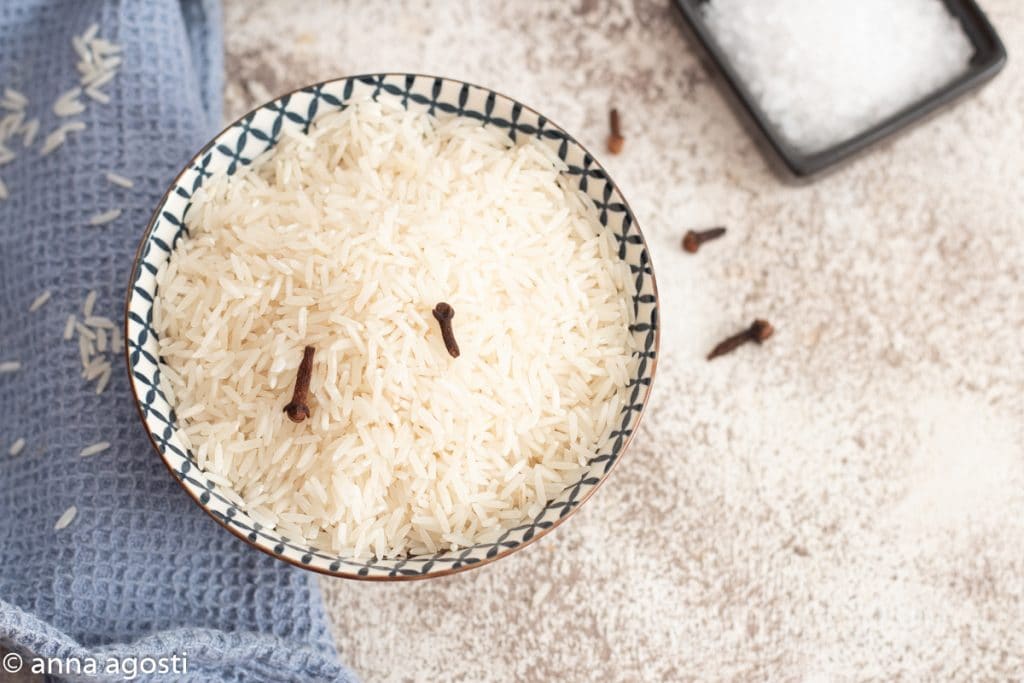How to cook basmati rice to get it perfect, fluffy, and not overcooked. Forget bland and sticky rice, and get ready to discover the secrets to impeccable cooking.
I’ll guide you through three of the most effective methods: absorption cooking, ideal for those seeking simplicity and practicality; steaming, which enhances the lightness and fragrance of the grain; and pilaf cooking, perfect for those who want to enrich the rice with flavors and aromas from the start.
With its long, slender grains and intoxicating aroma, it is the ideal companion for exotic curries, rich stews, or simply for summer salads or to accompany chicken.
Below, as always, I leave you plenty of ideas to use basmati rice and then we go right under the photo to discover How to cook basmati rice!!

- Difficulty: Very easy
- Cost: Very cheap
- Preparation time: 3 Minutes
- Portions: 4 People
- Cooking methods: Stovetop
- Cuisine: Italian
- Seasonality: All seasons
- Energy 90.29 (Kcal)
- Carbohydrates 16.16 (g) of which sugars 0.01 (g)
- Proteins 1.68 (g)
- Fat 1.03 (g) of which saturated 0.01 (g)of which unsaturated 0.01 (g)
- Fibers 0.40 (g)
- Sodium 139.19 (mg)
Indicative values for a portion of 160 g processed in an automated way starting from the nutritional information available on the CREA* and FoodData Central** databases. It is not food and / or nutritional advice.
* CREATES Food and Nutrition Research Center: https://www.crea.gov.it/alimenti-e-nutrizione https://www.alimentinutrizione.it ** U.S. Department of Agriculture, Agricultural Research Service. FoodData Central, 2019. https://fdc.nal.usda.gov
What You Need to Cook Basmati Rice
- 11 oz Basmati rice
- 2 3/4 cups water
- 1 pinch coarse salt
- 2 cloves (optional)
Tools
- 1 Strainer
- 1 Pot
How to Cook Basmati Rice
Regardless of the chosen cooking method, a crucial step for basmati rice (and most oriental rices) is washing.
This serves to remove the excess starch on the surface of the grains, preventing the rice from becoming sticky.
Place the rice in a fine mesh strainer and rinse it repeatedly under cold running water.
Continue until you see clear water flowing from the strainer, then place the drained rice in a bowl and let it rest.
This helps the grains absorb water more evenly and cook better, remaining more compact; drain well before cooking.
The proportion of rice to water for absorption cooking is 1 to 2, so for 80 grams of rice (1 portion) you will need 160 ml of water.
I often use a coffee cup as a measure, 1 cup of rice, 2 cups of water.
Boil the water: In a pot with a heavy lid (preferably non-stick or with a thick bottom), pour the water and bring it to a boil over medium-high heat.
If desired, add the salt and cloves.
Add the rice: When the water boils, add the well-drained rice, stir quickly once to distribute the rice.
Cover and lower the heat: Immediately cover the pot with the lid, lower the heat to the minimum, and let it cook without ever lifting the lid.
In about 10-12 minutes the rice will be perfectly cooked. Do not open the lid because steam is essential for cooking.
Rest: After the cooking time, turn off the heat, but do not remove the lid. Allow the rice to rest in the covered pot for at least 5-10 minutes (even 15 minutes is fine).
This allows the grains to finish absorbing the residual steam and to fully swell, separating.
This method emphasizes the role of steam for an even more delicate cooking and ethereal grains. You can also do it without a steamer, using a “water bath” technique in a pot.
Pot and water for steaming: In a large pot, bring about 2-3 fingers of water to a boil. If you have a steamer to insert into the pot, place it.
If not, you can use a metal strainer that fits the pot without touching the water, or even a steam cooking basket.Prepare the rice in the cooking container: Place the well-drained rice in the steamer basket (or strainer) or, in a pot suitable for steaming with an insert, directly in the insert.
Add the water and salt directly to the rice in this container.
Steam cooking: Place the container with the rice over the boiling water (make sure that the rice does not touch the water). Cover the pot tightly with the lid.
Cook over medium-low heat for about 15-20 minutes, or until the water is completely absorbed and the rice is tender.
Rest: Turn off the heat and let the rice rest, covered, for another 5-10 minutes.
The pilaf method (or “pilau”) is not just a cooking method, but a true preparation that adds flavor to the rice from the start, often with a sauté and the addition of broth or spices. Pilaf rice is a classic of Middle Eastern and Indian cuisine.
Sauté (optional but recommended): In a pot with a thick lid, heat oil or butter over medium heat. If using onion, sauté until it becomes translucent (about 2-3 minutes).
If using whole spices (cloves, cardamom, etc.), add them to the sauté and let them release their aroma for about a minute.
Rice toasting: Add the well-drained basmati rice to the pot and toast it, stirring continuously for 2-3 minutes, until the grains become translucent at the edges.
This step is crucial to seal the starch and make the rice well-separated.
Add the liquid: Pour in the hot broth (or hot water) and powdered spices (e.g., turmeric) if you want to use them, season with salt, and stir once.
Absorption cooking: Bring the liquid to a boil, then cover the pot with an airtight lid, lower the heat to the minimum, and let it cook for about 12-15 minutes (without ever opening the lid).
Rest: Turn off the heat and let the rice rest in the covered pot for another 5-10 minutes. Here too, rest is crucial for the perfection of the grain.
Storage and Tips
Always fluff the rice gently with a fork to separate the grains regardless of the chosen cooking method.
Once cooked, fluffy, and cooled, basmati rice can be stored in the refrigerator well sealed in an airtight container for 2 days.
Customization: Pilaf is extremely versatile! You can add finely chopped vegetables (peas, carrots), dried fruit (raisins, toasted almonds), or fresh herbs at the end.
Extra soaking: For steaming, a soak of 30 minutes or even an hour can make a difference for even cooking and perfect grains.
NEVER cool cooked basmati rice under cold water, simply fluff it with a fork and dress it with a drizzle of extra virgin olive oil, allowing it to cool at room temperature.
Other Recipes
If you want to see other types of recipes you can return to HOME. If you don’t want to miss any recipe, you can follow me on my Facebook Page, just activate the notifications and you’ll see how many new recipes every day.

